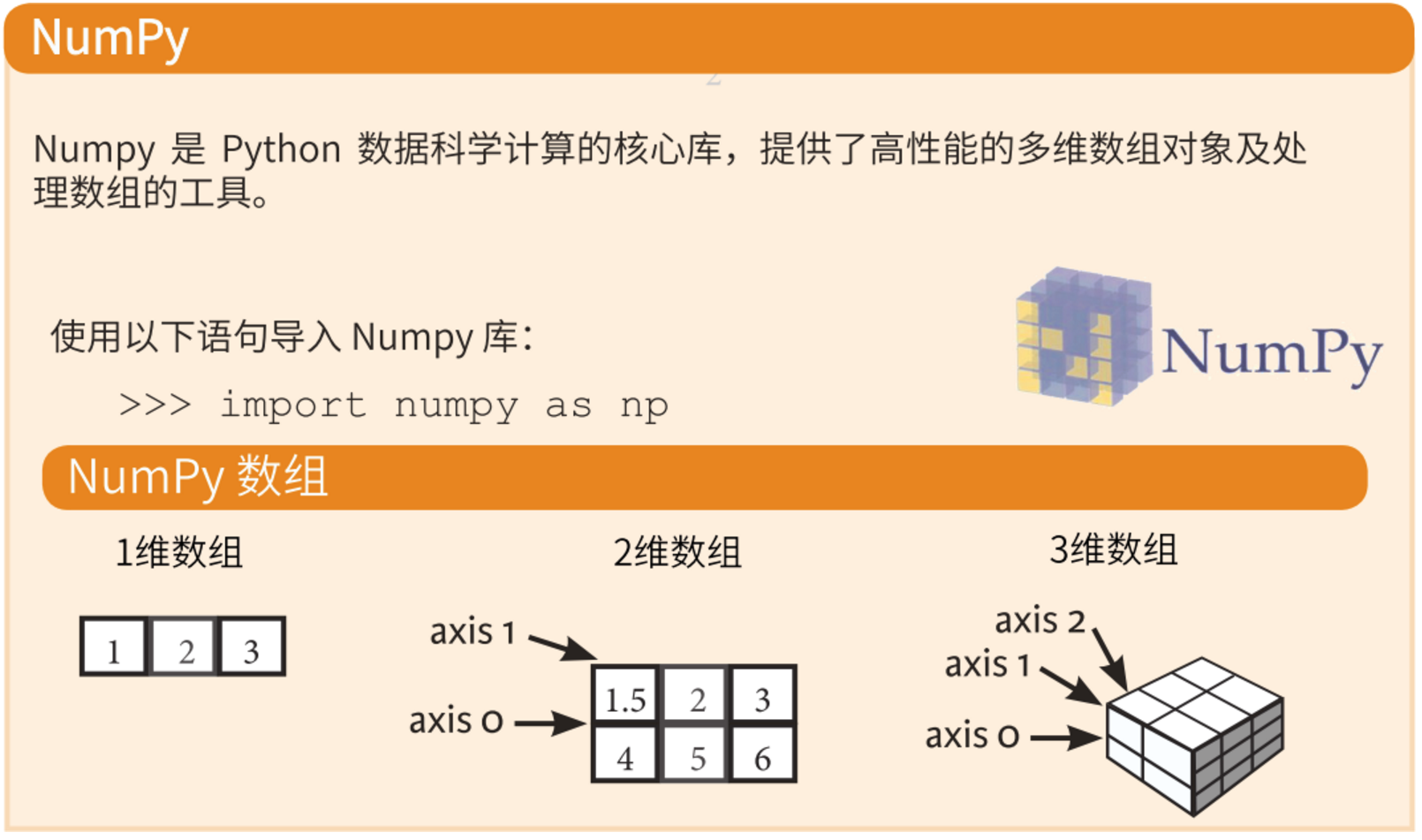背景
什么是 NumPy 呢?

NumPy 这个词来源于两个单词 – Numerical和Python。其是一个功能强大的 Python 库,可以帮助程序员轻松地进行数值计算,通常应用于以下场景:
- 执行各种数学任务,如:数值积分、微分、内插、外推等。因此,当涉及到数学任务时,它形成了一种基于 Python 的 MATLAB 的快速替代。
- 计算机中的图像表示为多维数字数组。NumPy 提供了一些优秀的库函数来快速处理图像。例如,镜像图像、按特定角度旋转图像等。
- 在编写机器学习算法时,需要对矩阵进行各种数值计算。如:矩阵乘法、求逆、换位、加法等。NumPy 数组用于存储训练数据和机器学习模型的参数。
排序,搜索和计数
排序
numpy.sort(a[, axis=-1, kind='quicksort', order=None])Return a sorted copy of an array.- axis:排序沿数组的(轴)方向,0表示按行,1表示按列,None表示展开来排序,默认为-1,表示沿最后的轴排序。
- kind:排序的算法,提供了快排’quicksort’、混排’mergesort’、堆排’heapsort’, 默认为‘quicksort’。
- order:排序的字段名,可指定字段排序,默认为None。
【例】
import numpy as npnp.random.seed(20200612)
x = np.random.rand(5, 5) * 10
x = np.around(x, 2)
print(x)
# [[2.32 7.54 9.78 1.73 6.22]
# [6.93 5.17 9.28 9.76 8.25]
# [0.01 4.23 0.19 1.73 9.27]
# [7.99 4.97 0.88 7.32 4.29]
# [9.05 0.07 8.95 7.9 6.99]]y = np.sort(x)
print(y)
# [[1.73 2.32 6.22 7.54 9.78]
# [5.17 6.93 8.25 9.28 9.76]
# [0.01 0.19 1.73 4.23 9.27]
# [0.88 4.29 4.97 7.32 7.99]
# [0.07 6.99 7.9 8.95 9.05]]y = np.sort(x, axis=0)
print(y)
# [[0.01 0.07 0.19 1.73 4.29]
# [2.32 4.23 0.88 1.73 6.22]
# [6.93 4.97 8.95 7.32 6.99]
# [7.99 5.17 9.28 7.9 8.25]
# [9.05 7.54 9.78 9.76 9.27]]y = np.sort(x, axis=1)
print(y)
# [[1.73 2.32 6.22 7.54 9.78]
# [5.17 6.93 8.25 9.28 9.76]
# [0.01 0.19 1.73 4.23 9.27]
# [0.88 4.29 4.97 7.32 7.99]
# [0.07 6.99 7.9 8.95 9.05]]
【例】
import numpy as npdt = np.dtype([('name', 'S10'), ('age', np.int)])
a = np.array([("Mike", 21), ("Nancy", 25), ("Bob", 17), ("Jane", 27)], dtype=dt)
b = np.sort(a, order='name')
print(b)
# [(b'Bob', 17) (b'Jane', 27) (b'Mike', 21) (b'Nancy', 25)]b = np.sort(a, order='age')
print(b)
# [(b'Bob', 17) (b'Mike', 21) (b'Nancy', 25) (b'Jane', 27)]
如果排序后,想用元素的索引位置替代排序后的实际结果,该怎么办呢?
numpy.argsort(a[, axis=-1, kind='quicksort', order=None])Returns the indices that would sort an array.
【例】对数组沿给定轴执行间接排序,并使用指定排序类型返回数据的索引数组。这个索引数组用于构造排序后的数组。
import numpy as npnp.random.seed(20200612)
x = np.random.randint(0, 10, 10)
print(x)
# [6 1 8 5 5 4 1 2 9 1]y = np.argsort(x)
print(y)
# [1 6 9 7 5 3 4 0 2 8]print(x[y])
# [1 1 1 2 4 5 5 6 8 9]y = np.argsort(-x)
print(y)
# [8 2 0 3 4 5 7 1 6 9]print(x[y])
# [9 8 6 5 5 4 2 1 1 1]
【例】
import numpy as npnp.random.seed(20200612)
x = np.random.rand(5, 5) * 10
x = np.around(x, 2)
print(x)
# [[2.32 7.54 9.78 1.73 6.22]
# [6.93 5.17 9.28 9.76 8.25]
# [0.01 4.23 0.19 1.73 9.27]
# [7.99 4.97 0.88 7.32 4.29]
# [9.05 0.07 8.95 7.9 6.99]]y = np.argsort(x)
print(y)
# [[3 0 4 1 2]
# [1 0 4 2 3]
# [0 2 3 1 4]
# [2 4 1 3 0]
# [1 4 3 2 0]]y = np.argsort(x, axis=0)
print(y)
# [[2 4 2 0 3]
# [0 2 3 2 0]
# [1 3 4 3 4]
# [3 1 1 4 1]
# [4 0 0 1 2]]y = np.argsort(x, axis=1)
print(y)
# [[3 0 4 1 2]
# [1 0 4 2 3]
# [0 2 3 1 4]
# [2 4 1 3 0]
# [1 4 3 2 0]]y = np.array([np.take(x[i], np.argsort(x[i])) for i in range(5)])
print(y)
# [[1.73 2.32 6.22 7.54 9.78]
# [5.17 6.93 8.25 9.28 9.76]
# [0.01 0.19 1.73 4.23 9.27]
# [0.88 4.29 4.97 7.32 7.99]
# [0.07 6.99 7.9 8.95 9.05]]
如何将数据按照某一指标进行排序呢?
numpy.lexsort(keys[, axis=-1])Perform an indirect stable sort using a sequence of keys.
【例】按照第一列的升序或者降序对整体数据进行排序。
import numpy as npnp.random.seed(20200612)
x = np.random.rand(5, 5) * 10
x = np.around(x, 2)
print(x)
# [[2.32 7.54 9.78 1.73 6.22]
# [6.93 5.17 9.28 9.76 8.25]
# [0.01 4.23 0.19 1.73 9.27]
# [7.99 4.97 0.88 7.32 4.29]
# [9.05 0.07 8.95 7.9 6.99]]index = np.lexsort([x[:, 0]])
print(index)
# [2 0 1 3 4]y = x[index]
print(y)
# [[0.01 4.23 0.19 1.73 9.27]
# [2.32 7.54 9.78 1.73 6.22]
# [6.93 5.17 9.28 9.76 8.25]
# [7.99 4.97 0.88 7.32 4.29]
# [9.05 0.07 8.95 7.9 6.99]]index = np.lexsort([-1 * x[:, 0]])
print(index)
# [4 3 1 0 2]y = x[index]
print(y)
# [[9.05 0.07 8.95 7.9 6.99]
# [7.99 4.97 0.88 7.32 4.29]
# [6.93 5.17 9.28 9.76 8.25]
# [2.32 7.54 9.78 1.73 6.22]
# [0.01 4.23 0.19 1.73 9.27]]
【例】
import numpy as npx = np.array([1, 5, 1, 4, 3, 4, 4])
y = np.array([9, 4, 0, 4, 0, 2, 1])
a = np.lexsort([x])
b = np.lexsort([y])
print(a)
# [0 2 4 3 5 6 1]
print(x[a])
# [1 1 3 4 4 4 5]print(b)
# [2 4 6 5 1 3 0]
print(y[b])
# [0 0 1 2 4 4 9]z = np.lexsort([y, x])
print(z)
# [2 0 4 6 5 3 1]
print(x[z])
# [1 1 3 4 4 4 5]z = np.lexsort([x, y])
print(z)
# [2 4 6 5 3 1 0]
print(y[z])
# [0 0 1 2 4 4 9]
搜索
numpy.argmax(a[, axis=None, out=None])Returns the indices of the maximum values along an axis.
【例】
import numpy as npnp.random.seed(20200612)
x = np.random.rand(5, 5) * 10
x = np.around(x, 2)
print(x)
# [[2.32 7.54 9.78 1.73 6.22]
# [6.93 5.17 9.28 9.76 8.25]
# [0.01 4.23 0.19 1.73 9.27]
# [7.99 4.97 0.88 7.32 4.29]
# [9.05 0.07 8.95 7.9 6.99]]y = np.argmax(x)
print(y) # 2y = np.argmax(x, axis=0)
print(y)
# [4 0 0 1 2]y = np.argmax(x, axis=1)
print(y)
# [2 3 4 0 0]
numpy.argmin(a[, axis=None, out=None])Returns the indices of the minimum values along an axis.
【例】
import numpy as npnp.random.seed(20200612)
x = np.random.rand(5, 5) * 10
x = np.around(x, 2)
print(x)
# [[2.32 7.54 9.78 1.73 6.22]
# [6.93 5.17 9.28 9.76 8.25]
# [0.01 4.23 0.19 1.73 9.27]
# [7.99 4.97 0.88 7.32 4.29]
# [9.05 0.07 8.95 7.9 6.99]]y = np.argmin(x)
print(y) # 10y = np.argmin(x, axis=0)
print(y)
# [2 4 2 0 3]y = np.argmin(x, axis=1)
print(y)
# [3 1 0 2 1]
numpy.where(condition, [x=None, y=None])函数返回输入数组中满足给定条件的元素的索引。
【例】
import numpy as npx = np.array([1, 2, 3, 4, 5, 6, 7, 8])
y = np.where(x > 5)
print(y)
# (array([5, 6, 7], dtype=int64),)
print(x[y])
# [6 7 8]x = np.array([[11, 12, 13, 14, 15],[16, 17, 18, 19, 20],[21, 22, 23, 24, 25],[26, 27, 28, 29, 30],[31, 32, 33, 34, 35]])
y = np.where(x > 25)
print(y)
# (array([3, 3, 3, 3, 3, 4, 4, 4, 4, 4], dtype=int64), array([0, 1, 2, 3, 4, 0, 1, 2, 3, 4], dtype=int64))print(x[y])
# [26 27 28 29 30 31 32 33 34 35]
numpy.searchsorted(a, v[, side='left', sorter=None])Find indices where elements should be inserted to maintain order.- a:一维输入数组。当
sorter参数为None的时候,a必须为升序数组;否则,sorter不能为空,存放a中元素的index,用于反映a数组的升序排列方式。 - v:插入
a数组的值,可以为单个元素,list或者ndarray。 - side:查询方向,当为
left时,将返回第一个符合条件的元素下标;当为right时,将返回最后一个符合条件的元素下标。 - sorter:一维数组存放
a数组元素的 index,index 对应元素为升序。
- a:一维输入数组。当
【例】
import numpy as npx = np.array([0, 1, 5, 9, 11, 18, 26, 33])
y = np.searchsorted(x, 15)
print(y) # 5y = np.searchsorted(x, 15, side='right')
print(y) # 5y = np.searchsorted(x, -1)
print(y) # 0y = np.searchsorted(x, -1, side='right')
print(y) # 0y = np.searchsorted(x, 35)
print(y) # 8y = np.searchsorted(x, 35, side='right')
print(y) # 8y = np.searchsorted(x, 11)
print(y) # 4y = np.searchsorted(x, 11, side='right')
print(y) # 5y = np.searchsorted(x, 0)
print(y) # 0y = np.searchsorted(x, 0, side='right')
print(y) # 1y = np.searchsorted(x, 33)
print(y) # 7y = np.searchsorted(x, 33, side='right')
print(y) # 8
【例】
import numpy as npx = np.array([0, 1, 5, 9, 11, 18, 26, 33])
y = np.searchsorted(x, [-1, 0, 11, 15, 33, 35])
print(y) # [0 0 4 5 7 8]y = np.searchsorted(x, [-1, 0, 11, 15, 33, 35], side='right')
print(y) # [0 1 5 5 8 8]
【例】
import numpy as npx = np.array([0, 1, 5, 9, 11, 18, 26, 33])
np.random.shuffle(x)
print(x) # [33 1 9 18 11 26 0 5]x_sort = np.argsort(x)
print(x_sort) # [6 1 7 2 4 3 5 0]y = np.searchsorted(x, [-1, 0, 11, 15, 33, 35], sorter=x_sort)
print(y) # [0 0 4 5 7 8]y = np.searchsorted(x, [-1, 0, 11, 15, 33, 35], side='right', sorter=x_sort)
print(y) # [0 1 5 5 8 8]
计数
numpy.count_nonzero(a, axis=None)Counts the number of non-zero values in the array a.
【例】返回数组中的非0元素个数。
import numpy as npx = np.count_nonzero(np.eye(4))
print(x) # 4x = np.count_nonzero([[0, 1, 7, 0, 0], [3, 0, 0, 2, 19]])
print(x) # 5x = np.count_nonzero([[0, 1, 7, 0, 0], [3, 0, 0, 2, 19]], axis=0)
print(x) # [1 1 1 1 1]x = np.count_nonzero([[0, 1, 7, 0, 0], [3, 0, 0, 2, 19]], axis=1)
print(x) # [2 3]
当前活动

我是 终身学习者“老马”,一个长期践行“结伴式学习”理念的 中年大叔。
我崇尚分享,渴望成长,于2010年创立了“LSGO软件技术团队”,并加入了国内著名的开源组织“Datawhale”,也是“Dre@mtech”、“智能机器人研究中心”和“大数据与哲学社会科学实验室”的一员。
愿我们一起学习,一起进步,相互陪伴,共同成长。
后台回复「搜搜搜」,随机获取电子资源!
欢迎关注,请扫描二维码:







